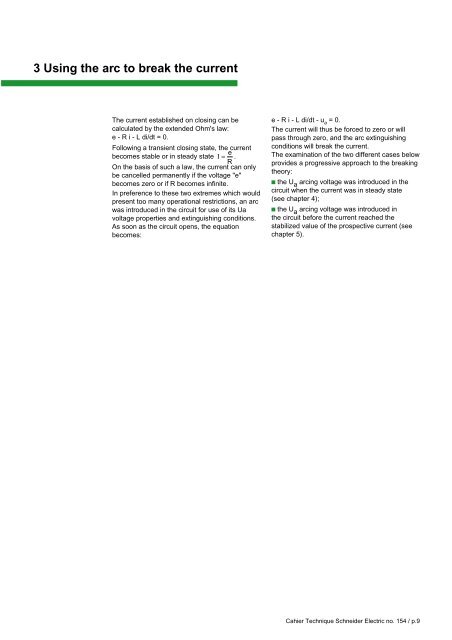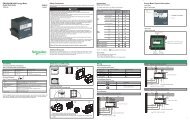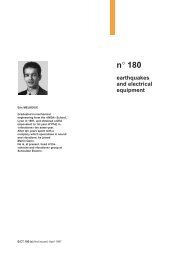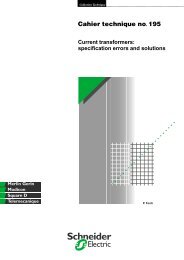Dielectric aspectThe arcing current is not extinguished merely byreaching zero. In addition, the atmosphereionised up to that point must be dielectricallyregenerated in order to "withstand" the mainsvoltage still present !These regeneration phenomena ofrecombination of + or - ions and electrons arefortunately very fast ! Thus, in practice, for thearcing current to remain zero, mains voltagemust be less than the regeneration characteristic(Ud). If arcing voltage becomes and remainsgreater than mains voltage (in absolute value forac voltage), regeneration will begin as thecurrent zero approaches. The number of plasmaelectric charges adjusts itself to the strictminimum and becomes zero at the same time asthe current.However the arc and the stray capacities havethe same voltage until the arcing current isextinguished. Once this happens, this voltagerejoins mains voltage through free oscillationbetween these distributed capacities and <strong>circuit</strong>constants L and R (see fig. 5 ). This voltage"connection" is known as the Transient Recovery<strong>Voltage</strong> (TRV).<strong>Low</strong> capacities mean these oscillations have avery high frequency and are extremely damped.These conditions are present:c in dc voltage: (see fig. 6a);The arcing voltage, Ua, is greater than mainsvoltage, Ur, when the current is cancelled, andthe regeneration characteristic, Ud, remainsgreater than Ur with TRV.c in ac voltage:v when the instantaneous mains voltage valuestill has the same sign as arcing voltage at thetime of current zero (see fig. 6b ). Final <strong>breaking</strong>will occur when subsequent change in mainsvoltage ceases to cross the regenerationcharacteristics in either positive or negativevalues.v when the instantaneous mains voltage valuehas the opposite sign to arcing voltage but has anabsolute lower value (see fig. 6c ). The arc ispermanently extinguished if the TRV does notexceed the regeneration characteristic.Otherwise, when the TRV breaks theregeneration "curve", a postarcing current of theelectroluminescent type may appear. In thiscase:- if the postarcing current is still of the smalltype, extinguishing conditions are still present;- if the postarcing current exceeds a criticalvalue under an equally critical voltage, thearcing current will be recovered and another"zero" will be required to break.ai,ubi,uU aiU aiUrUd +tti,uUdUrimiaU aUr«TRV»ci,uU aiUd -Ud +imttL,rUrEC TRViFig. 5: the transient recovery voltage, TRV.Ud -Fig. 6: arc in extinguishing condition.a- in d.c. voltageb- in a.c. voltage with Ur of same sign as U a at the timeof zero current,c- in a.c. voltage with Ur of opposite sign to U a .Cahier Technique <strong>Schneider</strong> <strong>Electric</strong> no. 154 / p.8
3 Using the arc to break the currentThe current established on closing can becalculated by the extended Ohm's law:e - R i - L di/dt = 0.Following a transient closing state, the currentbecomes stable or in steady state I = e R .On the basis of such a law, the current can onlybe cancelled permanently if the voltage "e"becomes zero or if R becomes infinite.In preference to these two extremes which wouldpresent too many operational restrictions, an arcwas introduced in the <strong>circuit</strong> for use of its Uavoltage properties and extinguishing conditions.As soon as the <strong>circuit</strong> opens, the equationbecomes:e - R i - L di/dt - u a= 0.The current will thus be forced to zero or willpass through zero, and the arc extinguishingconditions will break the current.The examination of the two different cases belowprovides a progressive approach to the <strong>breaking</strong>theory:c the U a arcing voltage was introduced in the<strong>circuit</strong> when the current was in steady state(see chapter 4);c the U a arcing voltage was introduced inthe <strong>circuit</strong> before the current reached thestabilized value of the prospective current (seechapter 5).Cahier Technique <strong>Schneider</strong> <strong>Electric</strong> no. 154 / p.9
















